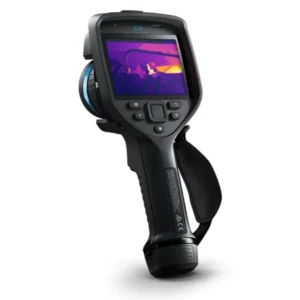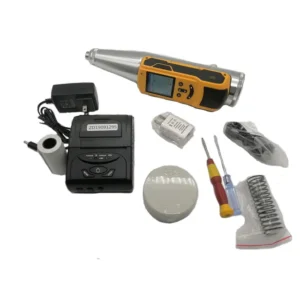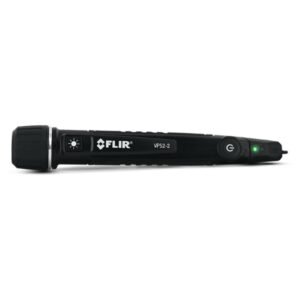Help Center
Help Center
₹4,229,000.00 Original price was: ₹4,229,000.00.₹4,200,000.00Current price is: ₹4,200,000.00. inc. Gst
Product Overview
| Brand | Flir |
| Model | G-Series |
| IR Resolution | 320 × 240 (76,800 pixels) |
| Spectral Range | 3.2 µm to 3.4 µm |
| Detector Pitch | 30 μm |
| Accuracy | ±1°C (0–100°C) or ±2% (>100°C) |
| Thermal Sensitivity | <10 mK at 30°C |
| Field of View | 24° × 18° (23 mm) |
| Display | 4″ LCD (640 × 480), OLED viewfinder (800 × 480) |
| Focus | Manual |
| Zoom | 1 – 8× digital zoom |
| Image Modes | IR, Visual, HSM, Noise Filter |
| Radiometric Video | RTRR (.csq), Over UVC |
| Communication | USB 2.0, Wi-Fi, Bluetooth, HDMI |
| Storage | Removable SD card, JPEG format |
| GPS | Built-in, removable |
| Battery | Rechargeable Li-ion, >2.5 hrs, 7.4 V |
| Operating Temp | -20°C to 50°C |
| Dimensions (L×W×H) | 251.6 × 164.5 × 170.9 mm |
| Weight | 3 kg |
| Certifications | IP54, ATEX, CSA, ANSI/ISA, RoHS, RED, EMC |
| Accessories Included | Battery x2, Charger, Cables, Case, Straps, Tools, etc. |
In stock
The FLIR G-Series is a high-performance Optical Gas Imaging (OGI) camera built for professionals in the oil and gas, chemical, and industrial safety sectors. Designed to detect and visualize invisible gas emissions with unmatched clarity and accuracy, the G-Series combines powerful thermal resolution, real-time quantification, and safety-focused design in a robust, field-ready package. From pinpointing methane leaks to monitoring refinery safety, this advanced camera helps industries reduce emissions, comply with regulations, and protect personnel with actionable insight.
1. Advanced Thermal Imaging with 320 x 240 IR Resolution
With a thermal resolution of 320 × 240 (76,800 pixels) and a thermal sensitivity of <10 mK at 30°C, the FLIR G-Series delivers crisp, high-contrast thermal images. It operates in a 3.2 µm to 3.4 µm spectral range, optimized for hydrocarbon gas detection. The cooled InSb detector and Stirling microcooler provide stable imaging in all environments.
2. Precise Gas Quantification and Measurement Tools
Integrated gas quantification tools allow you to measure leaks in real time with onboard analysis. Capable of detecting CH₄ at <9.6 ppm x m and multiple hydrocarbons at <4 ppm x m, this camera offers onboard delta T, spot meters (up to 10), and area measurement boxes (5 with min/max/avg). Custom temperature ranges from -20°C to 350°C make it suitable for both ambient and process monitoring.
3. Rotatable Touchscreen and Viewfinder Display
The camera includes a rotatable 4″ LCD touchscreen (640 x 480 pixels) and a built-in tiltable OLED viewfinder (800 x 480 pixels), offering flexible viewing angles in tough environments. Onscreen display allows simultaneous IR, visual, and HSM (High Sensitivity Mode) with image overlay and advanced filtering.
4. Radiometric Video, Image Capture, and Streaming
Capture radiometric JPGs, RTRR video files, and stream H.264/MPEG4/MJPEG videos over Wi-Fi or USB. MultiREC mode allows for recording multiple sequences in customizable order. FLIR Ignite cloud compatibility makes it easy to upload and organize data for collaborative inspections or regulatory documentation.
5. Industrial Grade Safety and Connectivity
With hazardous location compliance (ATEX/IECEx, Class I Division 2), the G-Series is engineered for use in explosive environments. It features IP54-rated sealing, shock and vibration resistance, and broad connectivity including USB 2.0, Wi-Fi (2.4 GHz/5 GHz), HDMI output, and Bluetooth. Built-in GPS logs image metadata, and integrated annotations (voice, text, sketch) enhance field documentation.
1. See the Unseen with Confidence
You can now visualize invisible gas leaks and thermal anomalies in real time. The FLIR G-Series’s high sensitivity and spectral tuning ensure that even the smallest emissions are detectable, helping you catch and fix problems before they become costly disasters.
2. Designed for Harsh, High-Risk Environments
Certified for hazardous locations, shock-resistant, and sealed against dust and water (IP54), this camera is built for dangerous industrial zones. Whether you’re climbing platforms or inspecting pipelines, the G-Series is made to survive and perform.
3. Real-Time Quantification Saves Time & Money
Forget estimating leaks by eye. The built-in quantification system tells you exactly how much gas is escaping—making your reports more precise and your repairs more targeted. It also helps you comply with global methane emission reduction standards.
4. Rich Data Capture and Seamless Reporting
Record, annotate, stream, and share—this camera supports radiometric JPEGs, thermal videos, GPS tagging, and more. Upload directly to FLIR Ignite for secure cloud access and reporting, making inspections more collaborative and efficient.
5. Professional Workflow Integration
From touchscreen operation to multiple language support (21+), the user interface is designed for ease and speed. Long battery life, removable SD storage, multi-format video out (HDMI/DVI), and inspection route support ensure it fits smoothly into professional maintenance routines.
1. Power Up and Navigate the Display
Start by charging the FLIR G-Series with the included 7.4V Li-ion battery using the provided charger and power adapter. Once charged, press the power button to initiate boot-up—note that it takes about 7 minutes to fully start. The 4-inch rotatable LCD and tiltable OLED viewfinder provide sharp visuals and easy access to menus for thermal settings, video capture, and annotations.
2. Select Thermal Settings and Color Palette
Use the interface to set your desired thermal mode. Choose from palettes like Arctic, White Hot, Black Hot, Iron, Lava, or Rainbow HC for clearer image contrast based on your application. Adjust image resolution, digital zoom (up to 8×), and switch between radiometric and streaming formats such as H.264 or MJPEG for real-time viewing or recording.
3. Perform Targeted Gas or Temperature Detection
Point the camera at the inspection target using the laser spot for centering. The cooled InSb FPA sensor detects even slight variations with <10 mK sensitivity and an accuracy of ±1°C or ±2%. You can capture gas leaks (like CH₄ or hydrocarbons) or heat anomalies using predefined subranges from -20°C to 350°C.
4. Analyze and Annotate Images Onboard
Use built-in tools like 10 spot measurements, 5 boxes, delta T analysis, and live line graphs to examine data directly on-screen. Sketch over IR images, record 60-second voice notes, or type text directly into the image metadata. GPS integration adds precise location to each file automatically.
5. Save, Transfer, or Upload Data
Store your thermal images and videos on the removable SD card in JPEG or .csq formats. Use USB, Wi-Fi, Bluetooth, or HDMI output for transferring files to external devices or for live streaming. You can also connect to FLIR Ignite cloud to auto-upload data wirelessly and ensure secure backups during field operations.
1. Clean Lenses and Display Gently
Use a soft microfiber cloth to clean the LCD screen, OLED viewfinder, and lens. Avoid liquids or rough materials. Always replace the front and rear lens caps (based on 80 mm or 92 mm) when not in use to protect the optics from scratches or debris.
2. Store Safely in Hard Case
After every session, pack the camera, batteries, lenses, SD card, and tools into the supplied hard transport case. This keeps everything safe from shock, moisture, and dust, especially during transit or long-term storage in outdoor conditions.
3. Avoid Extreme Weather and Sunlight
The device can operate between -20°C and 50°C, but avoid leaving it exposed to direct sunlight or freezing cold for extended periods. Store within the safe range of -30°C to 60°C and avoid high-humidity environments that could affect internal components.
4. Recharge and Rotate Batteries
Charge each 7.4V Li-ion battery fully before use (approx. 2.5 hours per battery). For extended fieldwork, always carry a spare battery. Avoid deep discharges and recharge the batteries every few months even when not in use to prolong battery life.
5. Handle Lenses and Accessories with Care
When switching between 14.5° or 24° manual-focus lenses, do so on a clean, stable surface. Avoid over-tightening. Keep the camera’s mounting threads and internal connectors free of dust. Always use only FLIR-approved parts to maintain warranty and performance.
1. Never Aim at Human or Animal Eyes
The integrated laser spot should never be directed toward anyone’s eyes. Although low-powered, direct exposure to laser beams or reflections can cause temporary blindness or disorientation.
2. Handle with Both Hands When In Use
Weighing 3 kg, the device is heavy. Always secure the handstrap or neckstrap before operating to avoid accidental drops or arm fatigue during prolonged inspections.
3. Use in Certified Zones Only
The FLIR G-Series is ATEX, IECEx, and ANSI/ISA certified for use in hazardous environments, but always confirm local compliance before use in explosive zones. Refer to Class I, Division 2 guidelines if used near flammable gases or dust.
4. Keep Away from Unauthorized Users
This is an advanced industrial-grade thermal camera. Always keep it stored in a secure place, away from untrained users, children, or curious hands to prevent misuse or damage.
5. Follow RF Transmission Guidelines
When using Wi-Fi or Bluetooth features, be aware of RF output limits (Wi-Fi <17 dBm, Bluetooth <10 dBm). Always turn off wireless modes when operating in RF-restricted or sensitive environments like hospitals or airports.
The FLIR G-Series Thermal Camera is engineered for serious professionals who need unmatched accuracy in detecting gas leaks, heat irregularities, or equipment inefficiencies. With a cooled InSb detector, ultra-high thermal sensitivity (<10 mK), precise temperature detection, and intelligent gas quantification, it offers the best-in-class performance. Its rotating LCD, dual video output, 8× zoom, and powerful onboard analysis tools make field diagnostics not just possible—but easy. Certified for hazardous environments and built with robust IP54 protection, it’s the ideal choice for energy, oil & gas, and industrial inspection teams who need a smart, rugged, and reliable thermal solution.
| Category | Specification |
|---|---|
| IR Resolution | 320 × 240 thermal resolution (76,800 pixels) |
| Detector Pitch | 30 μm |
| Accuracy | ±1°C (0°C to 100°C) or ±2% of reading (>100°C) |
| Spectral Range | 3.2 µm to 3.4 µm |
| Hazardous Compliance | ATEX/IECEx, Ex ic nC op is IIC T4 Gc II 3 G, ANSI/ISA-12.12.01-2013, CSA 22.2 No. 213, Class I Division 2 |
| Adjustable Viewfinder | Built-in, tiltable OLED, 800 × 480 pixels |
| Camera f-number | 1.59 |
| Color LCD | 4″, 640 × 480 pixel, rotatable, touchscreen |
| Color Palettes | Arctic, White hot, Black hot, Iron, Lava, Rainbow, Rainbow HC |
| Detector Type | Focal plane array (FPA), cooled InSb |
| Display Frame Rate | 60 Hz |
| Field of View | 24° × 18° (23 mm) |
| Focus | Manual |
| Image Analysis | 10 spots, 5 boxes (max/min/avg), 1 line (H/V), measurement corrections |
| Image Modes | IR image, visual image, high sensitivity mode, noise reduction filter |
| Laser Spot | Yes |
| MPEG Video Recording | Yes |
| Non-Radiometric Video | H.264 (Wi-Fi), MPEG4 (Wi-Fi), MJPEG (UVC & Wi-Fi) |
| On-Camera Display | LCD (800 × 480), Tiltable OLED viewfinder (800 × 480) |
| Radiometric IR Video | RTRR (.csq), Over UVC |
| Radiometric JPG | Yes |
| Sensor Cooling | Stirling Microcooler (FLIR MC-3) |
| Video Recording | H.264 to memory card |
| Zoom | 1 – 8× continuous digital zoom |
| Area Box | 5 (min./max./avg.) |
| Delta T | Yes |
| Gas Quantification | Onboard quantification |
| Gas Sensitivity | CH₄: <9.6 ppm x m; Hydrocarbons (multiple): <4 ppm x m (ΔT = 10°C, Distance = 1 m) |
| Measurement Corrections | Reflected temperature, distance, atmospheric transmission, humidity, external optics |
| Profile | 1 live line (horizontal or vertical) |
| Recording | MultiREC; record multiple files in customizable order |
| Spot Meter | 10 |
| Temperature Range | -20°C to 350°C (-4°F to 662°F); Sub-ranges: -20 to 10°C, -10 to 25°C, 10 to 50°C, 40 to 85°C, 70 to 120°C, 100 to 160°C, 130 to 200°C, 180 to 260°C, 240 to 350°C |
| Thermal Sensitivity | <10 mK at 30°C (86°F) |
| Communication Interfaces | USB 2.0, Bluetooth (headset), Wi-Fi, HDMI |
| Image File Format | Standard JPEG with measurement data |
| Radio | Bluetooth + EDR (2402–2480 MHz), WLAN 2.4 GHz (2412–2462 MHz), WLAN 5 GHz (5150–5250 MHz) |
| RF Output (EIRP) | Bluetooth + EDR: <10 dBm, WLAN: <17 dBm |
| Antenna | Integrated PIFA (max gain: 2.6 dBi) |
| Storage Media | Removable SD card |
| Video Output | HDMI 640 × 480, HDMI 1280 × 720, DVI 640 × 480, DVI 800 × 600 |
| Annotations | Voice (60 sec), Text (predefined or touchscreen), Image Sketch (infrared only) |
| Cloud Services | FLIR Ignite (Wi-Fi), secure upload and sharing |
| FLIR Inspection Route | Enabled |
| GPS | Built-in, removable; logs location on stills and first video frame |
| Laser Pointer | Class 2 |
| Package Includes | Camera with lens, 2× battery, charger, power supply, hand/neck straps, lens cap & strap, SD card, HDMI cable, USB cable, screwdriver, screw, documentation, hard case |
| Packaging Size | 600 mm × 510 mm × 410 mm (23.6 in × 20.1 in × 16.1 in) |
| Size with Lens (L×W×H) | 251.6 mm × 164.5 mm × 170.9 mm (9.9 in × 6.48 in × 6.73 in) |
| Weight | 3 kg (6.18 lb) |
| User Interface Languages | 21 |
| Battery Time | >2.5 hours at 25°C |
| Battery Type | Rechargeable Li-ion, 7.4 V |
| Charging Time | 2.5 hours to 95% with LED status |
| Startup Time | ~7 minutes at 25°C |
| Certifications | RoHS, WEEE, RED, EMC, FCC, ICES, IP54 |
| Encapsulation | IP54 (IEC 60529) |
| Mounting | UNC ¼”-20 |
| Operating Temp Range | -20°C to 50°C (-4°F to 122°F) |
| Storage Temp Range | -30°C to 60°C (-22°F to 140°F) |
| Shock & Vibration | Shock: 25 g (IEC 60068-2-27), Vibration: 2 g (IEC 60068-2-6) |
| Category | Item Description |
|---|---|
| Cases and Pouches | T911881ACC Camera Bag and Harness |
| Batteries and Power | FLIR Adapter Automotive 12 V (round connector) |
| G-Series Battery (T300450ACC) | |
| G-Series Battery Charger (T300571ACC) | |
| Power Supply for Battery Charger (T911633ACC) | |
| Cables & Adapters | USB 2.0 Type A to Type C Cable, 1.0 m, Black (T911940ACC) |
| Straps and Holsters | Handstrap (T131757ACC) |
| Neckstrap (T131758ACC) | |
| Other Accessories | 16 GB SD Memory Card (T911975ACC) |
| Camera Body Cap (T131735ACC) | |
| Hard Transport Case for FLIR G-Series (T300580ACC) | |
| Lens Cap Back (T131726ACC) | |
| Lens Cap Front, 80 mm (T131724ACC) | |
| Lens Cap Front, 92 mm (T131725ACC) | |
| Screwdriver TX20 (T911309ACC) | |
| Lenses | Lens 14.5°, 3–5 µm Manual Focus (T300682) |
| Lens 24°, 3–5 µm Manual Focus (T300686) |

In stock

In stock

In stock

In stock
Reviews
There are no reviews yet.